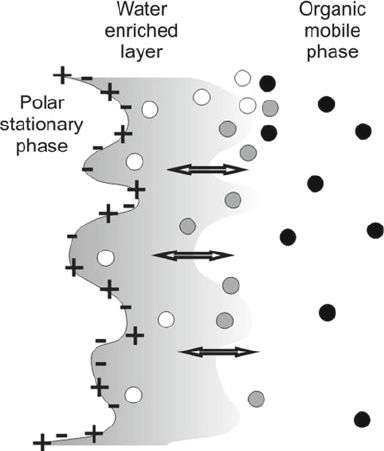Hydrophilic Interaction Chromatography-Based High-Throughput Glycan Screening Solution
Hydrophilic Interaction Chromatography-Based High-Throughput Glycan Screening Solution is specifically developed for research and industrial clients seeking efficient separation, identification, and quantitative analysis of glycans in complex samples. By integrating hydrophilic interaction chromatography (HILIC) with high-throughput analytical platforms, MtoZ Biolabs delivers precise profiling of glycan composition, structural features, and modification patterns within a short turnaround time. This solution provides robust data support for diverse applications, including vaccine development, antibody drug optimization, metabolomics research, and food science. It enhances detection sensitivity and separation efficiency while ensuring stable and reproducible results for large-scale glycan screening.
Technical Principles
HILIC is a chromatographic technique utilizing a polar stationary phase. In a mobile phase containing a high proportion of organic solvent, a hydration layer forms on the stationary phase surface, enabling polar interactions with analyte functional groups. This mechanism provides strong retention for polar compounds such as glycans and is particularly effective in resolving structurally similar glycan isomers. When coupled with automated sample injection and high-sensitivity detection systems (UV/Vis, fluorescence detection, or mass spectrometry), HILIC achieves high resolution while significantly increasing analytical speed and throughput.

Jensen, P. H. et al. Methods Mol Biol. 2013.
Figure 1. The Principle of HILIC
Analysis Workflow
Our Hydrophilic Interaction Chromatography-Based High-Throughput Glycan Screening Solution is built on a well-established and efficient workflow designed to deliver reliable glycan separation and analysis. Each step is carefully optimized to support high-throughput screening with consistent and reproducible results across different sample types.
1. Sample Preparation
Extract, purify, and concentrate glycans according to sample type, removing proteins, salts, and other interfering substances to maximize separation efficiency and detection sensitivity.
2. Chromatographic Condition Optimization
Select an appropriate HILIC column and mobile phase system. Optimize mobile phase composition, gradient profile, and temperature settings according to glycan polarity and analytical objectives.
3. Sample Loading and Separation
Inject prepared samples into the HILIC system via automated injection, achieving high-resolution glycan separation under high organic phase conditions through hydrophilic interactions.
4. Detection and Data Acquisition
Record retention time, peak shape, and intensity using UV/Vis detectors, fluorescence detectors (FLD), or mass spectrometry (MS).
5. Data Analysis
Process acquired data using specialized software to identify glycan structures, determine modification sites, and perform quantitative analysis. Deliver detailed glycan profiles and comprehensive analytical reports.
Why Choose MtoZ Biolabs?
✅ Advanced Platform: High-performance HILIC systems integrated with multiple detection technologies to ensure superior sensitivity and resolution.
✅ Extensive Expertise: In-depth experience in glycomics and glycan screening across diverse sample types, enabling accurate structural and quantitative analysis.
✅ Customized Solutions: Analytical strategies tailored to research goals and sample characteristics.
✅ Integrated Analysis: One-stop services covering structural elucidation, quantitative profiling, and pattern recognition.
✅ One-Time-Charge: Our pricing is transparent, no hidden fees or additional costs.
Sample Submission Suggestions
This Hydrophilic Interaction Chromatography-Based High-Throughput Glycan Screening Solution supports a wide range of sample sources, including blood, urine, saliva, tissue extracts, cell culture supernatants, microbial fermentation broths, food raw materials, pharmaceutical products, and other complex matrices containing glycoconjugates. Please indicate the sample source when submitting, allowing us to develop the most suitable analytical plan. MtoZ Biolabs provides a detailed sample submission guide upon request.
Applications
● Glycan Structure and Function Research: Characterization of glycan composition, isomer distribution, and modification profiles.
● Drug Development and Quality Control: Glycosylated drug consistency assessment and process optimization.
● Disease Biomarker Discovery: Identification of glycan patterns associated with specific diseases for diagnostic and classification purposes.
● Gut Microbiota Metabolism Research: Investigation of microbial utilization and transformation of glycans.
● Functional Food Development: Analysis of food-derived oligosaccharide composition and potential health benefits.
With advanced HILIC platforms and established high-throughput screening workflows, MtoZ Biolabs delivers precise, high-efficiency data for glycan research, drug development, and biomarker discovery. Our team combines rigorous technical standards with streamlined service processes to accelerate both basic research and applied development. Contact us to obtain a customized glycan screening solution.
FAQ
Q1: Does HILIC separation affect glycan structural integrity?
When performed under optimized chromatographic conditions, HILIC preserves the native structure and modification state of glycans. It minimizes the risk of structural changes or loss of labile modifications, ensuring accurate profiling.
Q2: How does HILIC maintain both separation efficiency and analytical speed in high-throughput screening?
HILIC supports fast and efficient glycan analysis through gradient optimization and automated sample injection. At MtoZ Biolabs, we use high-throughput LC platforms with multi-sequence operation to accelerate turnaround time while maintaining high resolution, making the solution ideal for drug development, clinical research, and functional food studies.
Q3: What are the key differences between HILIC and CE in glycan separation?
HILIC separates glycans based on interactions with a polar stationary phase, allowing direct analysis of native glycans and seamless MS integration. In contrast, CE (capillary electrophoresis) separates analytes by charge and size under an electric field, offering high resolution for charged or labeled glycans but typically requiring derivatization steps beforehand.
Related Services
High-Throughput Glycan Screening Solution
HPLC-Based High-Throughput Glycan Screening Solution
Automated LC-MS-Based High-Throughput Glycan Screening Solution
UHPLC-FLD-Based High-Throughput Glycan Screening Solution
CE-MS-Based High-Throughput Glycan Screening Solution
ESI-MSn-Based High-Throughput Glycan Screening Solution
MALDI-TOF-MS-Based High-Throughput Glycan Screening Solution
How to order?







